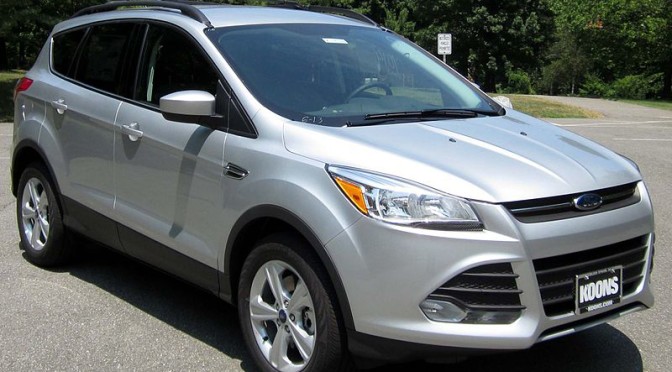I’ve spent a lot of time recently writing about how dangerous side impact collisions can be, and how to keep our loved ones alive if we’re unfortunate enough to be involved in them. First I described the safest cars of 2015 per IIHS side impact intrusion metrics. Next I wrote an article describing the safest minivans available in 2015 for surviving t-bones based on the same metric. I then set to work to write the equivalent article on surviving side impacts in SUVs made in 2015. Most recently, I wrote about how to survive side impact collisions in small cars made in 2015. Today’s article is the latest in the series, and brings the focus to small SUVs and crossovers currently on the road.
To put it simply, side impact collisions are the collisions that are most likely to take your life or the life of a loved one, when compared with front-, and rear-end collisions. From doing the math in an earlier post on side impact collisions, we know that even though only around 1 out of every 5 collisions involve side impacts, they lead to 1 out of every 3 vehicle occupant deaths in multiple vehicle collisions. In comparison, basically 1 out of 2 collisions involve frontal impacts, which lead to around 1 out of every 2 multiple collision deaths. Even more dramatically, while more than 1 out of every 4 collisions are rear enders, they only result in around 1 out of every 12 multiple collision deaths.
Looking at the numbers shows us side impacts are the collisions most likely to be fatal, even though they’re the least common. Knowing this, it’s worth figuring out how to reduce our risks of dying from one.
How to keep from dying in a side impact collision – what options do we have?
Unfortunately, if you live in the United States, you live in a country that isn’t the most willing to make changes to make our roads safer for everyone. In the US, you can drink much, much more before you’re considered drunk than you would in many parts of Europe (where the driver death rates are lower). Similarly, you don’t really have restrictions on how big your vehicle can be, regardless of how little experience you have as a driver. This isn’t the case in a number of other countries. You also live in a country that turns a blind eye toward many speed limits and is vehemently opposed to traffic cameras, despite their prevalence in countries with lower crash death rates. And of course, you’re also in a country where it’s hard to travel long (or short) distances inexpensively without driving.
I’ve written about some of these issues in past articles, such as one on why Swedish roads are among the safest in the world, and another on why driving in Europe is safer than driving in the US. I’ll have more articles soon about the things we can learn from other countries when it comes to driving safely.
However, until we’re willing to make a number of necessary changes, if you’re invested in keeping your family safe from death in t-bone collisions, I’d recommend you:
1.) Avoid driving (e.g., by using public transportation or by cycling or walking…eventually this leads to a critical mass where everyone is safer).
2.) Limit driving (by the same measures above and by combining trips).
3.) Drive the most side-impact-resistant vehicles possible.
Ultimately, to truly bring an end to side impact collisions, as well as to all collisions, we’re going to need to be forced to invest in the first two measures. I’d consider self-driving or autonomous vehicles to be part of “avoiding driving,” even though those aren’t going to eliminate collisions completely until the vast majority of vehicles on the road are no longer being driven by humans (the critical mass argument).
However, unless you’re in a position to completely follow step 1, you’ll need to focus on 2 and 3. Step 2 isn’t always feasible either, so this post focuses on Step 3, and deals specifically with choosing the safest small SUVs and crossovers available for side impact protection in the US in 2016. I’ve written about the best cars for surviving side impacts, the best small cars for surviving small impacts, the best minivans for surviving small impacts, and the best SUVs and crossovers for surviving small impacts, all for 2015 models. It’s time to focus on 2016 models, since the technology is always improving, and unfortunately, these crashes aren’t going away–not yet, anyway.
Calculating which small SUVs and crossovers are the safest for side impact collisions by structural integrity (crush distance)
I’ve written about the math behind these calculations in previous posts, such as in the relevant articles on surviving side impacts in 2015 cars, minivans, and SUVs and crossovers, so hop back to those articles to read about this in detail. The short version is that the IIHS runs a side impact test. It simulates a 3300 lb SUV crashing into the side of a vehicle at 31 mph, or 143.7KJ of kinetic energy. Every vehicle deforms somewhat at the B-pillar when absorbing such an impact, and there’s a subscore in the IIHS test known as the “structure and safety cage” looks into how close the B-pillar intrudes into the center of the driver’s seat during the collision. Less intrusion is better. Let’s see who has the least intrusion right now in the small SUV market.
I searched through the test scores of every small (compact) or mini (subcompact) SUV or crossover currently available in the US to make this best-of list. Keep in mind that the IIHS continually updates their side impact information while gathering additional information, so in a few months, it’s likely that these numbers may be slightly different. All data is accurate as of late October 2015, and all images are either from yours truly or courtesy of Wikipedia.
The safest small SUVs and crossovers for side impact collisions in 2016
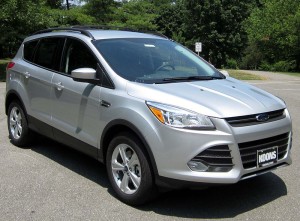 19.5 cm – 2013-2016 Ford Escape.
19.5 cm – 2013-2016 Ford Escape.
The current generation Ford Escape at 19.5 cm of intrusion protection was the highest-ranked small SUV in the overall 2015 SUV comparison, and it retains the title in 2016. The current Escape is a great improvement over the previous Escape, which only featured between 5.5 and 7.5 cm of intrusion protection. However, the current gen Escape still has a poor small overlap crash score, and is one of only a handful of vehicles on this list to do so. Ford can and needs to do better here, as more and more vehicles are acing the small overlap test, and the Escape is standing out in a bad way.
The ’09-’11 model years of the previous generation were estimated in the most recent driver death rate survey to have had DDRs of 27 and 35 in the 2WD and 4WD models respectively.
My full 3 across car seat guide to the Escape is available here.
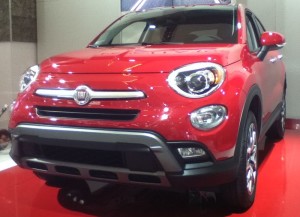 19 cm – 2016 Fiat 500X.
19 cm – 2016 Fiat 500X.
Hot on the heels of the Escape with 19 cm of impact resistance is the newly released Fiat 500X. It shares the same platform with the newly released Jeep Renegade and Fiat 500L, and is essentially a slightly Europeanized version of the Renegade. Fiat Chrysler Automobiles also scored a safety hit with the Fiat 500L, which was the most impact-resistant small car of 2015, and the Dodge Dart, which was the second best small car in 2015 for impact resistance. Unlike the 500L and Ford Escape, however, the 500X features a good small overlap score in addition to good scores in all other areas tested by the IIHS.
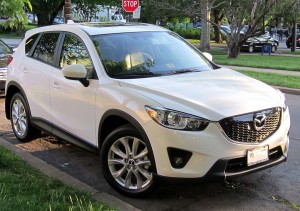 18.5 cm – 2013-2016 Mazda CX-5.
18.5 cm – 2013-2016 Mazda CX-5.
Immediately after the Fiat comes the current generation Mazda CX-5. Once again, unlike the Escape, it has a good small overlap score, and has had one since the ’14 model year. As with several other vehicles on this list, I look forward to seeing the CX-5 show up on a driver death rate study; Mazda will need to sell more of them for it to make an appearance.
My full 3 across car seat guide to the CX-5 is available here.
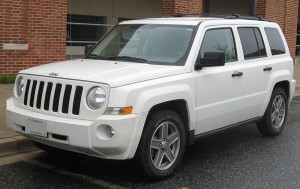 16.5 cm – 2014-2015 Jeep Patriot / Jeep Compass.
16.5 cm – 2014-2015 Jeep Patriot / Jeep Compass.
I have to admit that I almost forgot to include the Jeep Patriot or its curvy twin, the Compass. Both suffer from poor small overlap scores and are also among the only vehicles on the list to have no form of front crash prevention equipment whatsoever. However, with 16.5 cm of side impact resistance, both stand out in a good way, at least in this measure. These are also the second and third vehicles, respectively, by Fiat Chrysler Automobiles to make this list. The ’14 refresh of the Patriot / Compass also brought badly-needed side torso airbags to the front passenger seats; stay away from older years than 2014 if you’re considering used Patriots and Compasses.
The ’08-’11 model years of this generation were estimated in the most recent driver death rate survey to have had a DDRs of 7 for the 2WD Compass, and 11 and 57 for the 4WD and 2WD Patriots, respectively.
My full 3 across car seat guide to the Patriot is available here, while my Compass guide is available here.
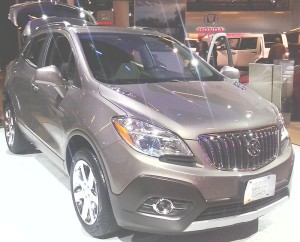 15.5 cm – 2013-2016 Buick Encore / Chevrolet Trax.
15.5 cm – 2013-2016 Buick Encore / Chevrolet Trax.
The Buick Encore and its twin, the Chevrolet Trax, are recent debuts in the small SUV / crossover market, but have already shown themselves to be strong contenders with 15.5 cm of side impact intrusion resistance. Once again, both feature good small overlap scores, and are among the first GM vehicles to show up on any of the impact resistance lists I’ve written so far.
You can read my full 3 across guide to the Encore / Trax here.
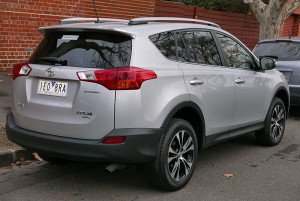 14.5-15 cm — 2013-2016 Toyota Rav4.
14.5-15 cm — 2013-2016 Toyota Rav4.
The Rav4 makes its first appearance in a positive light on this blog with the strong showing in 14.5-15 cm of side impact intrusion resistance. After being plagued with a poor small overlap score for years, Toyota finally addressed this in models built after November 2014, and now the Rav4 joins the ranks of small SUVs and crossovers with a good small overlap score.
Unfortunately, it still suffers from the overlapping seat belt issue; hopefully Toyota will address this soon, as it significantly limits the utility of this sport utility vehicle. For now, however, we can celebrate the improved small overlap score and the improvement in intrusion resistance over the previous generation, which featured only 7 cm of intrusion resistance. The ’08-’11 model years of that generation were estimated in the most recent driver death rate survey to have had DDRs of 19 and 35 in the 4WD and 2WD editions respectively.
My full 3 across car seat guide to the Rav4 is available here.
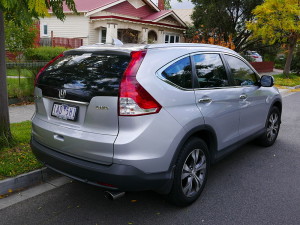 14 cm – 2015-2016 Honda CR-V.
14 cm – 2015-2016 Honda CR-V.
The CR-V has long been one of my favorite small SUVs due to its rock solid reliability, but until recently, it had been dogged by a marginal small overlap score. Honda finally addressed this in 2015, and now the CR-V joins the ranks of small crossovers with good scores up and down the board.
Featuring 14.5 cm of impact intrusion resistance, it remains competitive with some of the best small crossovers on the market today, although the current generation’s resistance is nearly identical to that of the previous generation at 13 cm. The ’08-’11 model years of that generation were estimated in the most recent driver death rate survey to have had DDRs of 17 and 19 in the 4WD and 2WD editions respectively.
My full 3 across car seat guide to the CR-V is available here.
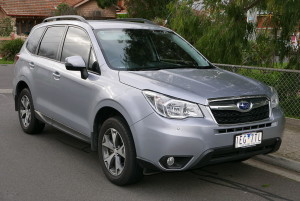 14 cm – 2014-2016 Subaru Forester.
14 cm – 2014-2016 Subaru Forester.
Tied with the CR-V at 14 cm is the Forester from Subaru. Like most of the vehicles on this list, it features a good small overlap score from 2014 onward, as well as good scores in every other area. The 14 cm is an improvement over the 11.5 cm of the previous generation Forester. The ’09-’11 model years of that generation were estimated in the most recent driver death rate survey to have had a DDR of 20.
My full 3 across car seat guide to the Forester is available here.
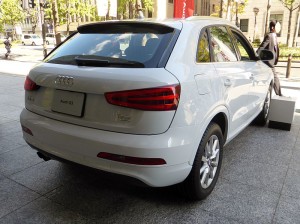 14 cm – 2015-2016 Audi Q3.
14 cm – 2015-2016 Audi Q3.
Finally, the Audi Q3 completes a 3-way tie with the Forester and CR-V at 14 cm of side impact intrusion resistance. The Q3 is a new entry from Audi, introduced in 2014 as a smaller counterpart to the mid-sized Q5, which itself is a smaller version of their Q7. Like nearly all vehicles on this list, it has good crash test scores, including a good small overlap score.
More broadly, once again, I have to give Fiat Chrysler Automobiles credit for making three of the most intrusion-resistant small SUVs available in the US market today in the Fiat 500X, Jeep Patriot, and Jeep Compass. They dominate this list the way they dominated the small car side impact resistance list of 2015, which they dominated the same way Volvo, Ford and Mercedes-Benz dominated the SUV/crossover list and Subaru, Fiat Chrysler Automobiles, and Mercedes-Benz dominated the overall car list. If you’re looking for safe vehicles, these are the manufacturers to pay attention to right now.
How to choose a small SUV or crossover to keep your loved ones safe in side impact crashes
In conclusion, the market for safe small SUVs keeps getting better every day in the United States. There are several compact crossovers that came within a fraction of a centimeter of making the list, but which I did not include in order to keep the list at the best of the best. The 2014-2016 Nissan Rogue, for example, featured 13.5 cm of intrusion resistance.
As in the other lists I’ve written, one of the overriding lessons is to consider the subscore for structural integrity rather than just stopping at the “good” overall side impact score. Small numbers can make a big difference in a high speed collision, and much as with an unbuckled seat belt, we don’t get the chance to change our minds in which vehicle we’ve chosen in the instant before a collision.
We can’t control everything. The safest option is still not driving at all, followed by driving as little as possible. But if you’ve got to drive, drive safely, and do your best to choose a safe vehicle. If you’re going to use it with children, definitely check out the plethora of best practice articles I’ve written here on choosing safe car seats, installation tips, seat reviews, and more information to help you make informed decisions.
I loved writing this article, and I hope you enjoyed reading it. I look forward to writing more articles examining various factors in car safety design and how they relate to keeping you and your loved ones safer while on the road. Stay tuned, remember to avoid common mistakes parents make with car seats, and check out some 3 across car seat guides while you’re here.
If you find the information on car safety, recommended car seats, and car seat reviews on this car seat blog helpful, you can shop through this Amazon link for any purchases, car seat-related or not. Canadians can shop through this link for Canadian purchases.

